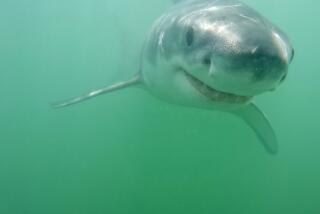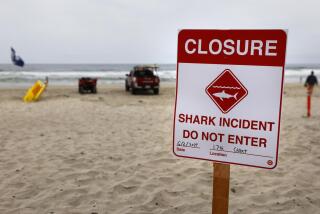Baja Divers’ Rap: Please, Hammerheads, Don’t Hurt ‘Em : Despite their fearsome appearance, the sharks at El Bajo, on the Sea of Cortez, are not man-eaters.
LA PAZ, Mexico — In his book “The Fishes of New York,” Samuel Latham Mitchell tells us that during the month of September, 1805, Joshua Turry of Riverhead, Long Island, N.Y., netted three hammerhead sharks.
“The largest,” Mitchell wrote, “was eleven feet long. On opening him, many detached parts of a man were found in his belly; these were collected and buried; there was also found a striped cotton shirt, patched on the sides and sleeves with bright-colored pieces.”
The disjointed somebody who was mentioned by Mitchell may well have been dead before his rendezvous with the shark. In fact, like most sharks, hammerheads pose little threat to people. But the thought that a hammerhead could complement its usual diet of stingrays with a human being is something held in common by all divers hoping to see one.
At least that’s the case with the divers who seek out hammerhead sharks at El Bajo, literally “the Deep Place,” a wide swatch of Sea of Cortez near La Paz, circled by sugary beaches and cacti standing on tan hills that enjoy less than an inch of rain every 100 years.
The same sun that broils the hills heats much of the sea to a glorious 80 degrees by late summer, luring more than 750 species of fish from the chilly Pacific. In so doing, it puts the Sea of Cortez in the same league as the Caribbean, the Red Sea and Micronesia as among the world’s best dive spots.
Although hammerhead sharks can be seen at El Bajo year-round, the underwater visibility is best from July through September. That’s also the best time for snorkelers to visit, as the water is warm and filled with more fish than in the colder months. Summer air temperatures often exceed 100 degrees, but it’s a very dry heat.
Amid the plethora of marine life at El Bajo are scalloped hammerheads, one of eight known hammerhead species, which can grow to at least 12 feet and have been seen in groups of several hundred. Within El Bajo, the place to find scalloped hammerheads (so named because of the scallop-resembling grooves in their heads) is the worn tip of a submerged extinct volcano known locally as the Sea Mount.
From boatside, the water above the Sea Mount is dark turquoise, and on a good day one can see the beige-sand top of the undersea mountain 80 feet below. Entering the water, a scuba diver sees schools of small fish, possibly a barracuda or two, and a sandy ocean bottom that now appears to be stitched together with patches.
As the diver descends to 30 or 40 feet, the “patches” are exposed for what they are: dark mounds of rock and coral typically rising some 10 feet off the ocean floor. And seen gracefully weaving between the piles--if the diver is lucky--are hammerheads apparently on the prowl for stingrays nestled beneath the sand.
The thing is, the hammerhead is an expert at ferreting out buried rays. Its head has evolved into a flat hydrofoil resembling a stubby airplane wing, permitting the shark to cruise almost effortlessly just above the ocean floor. The fish’s eyes are at the front of its head, and the whole structure is speckled with tiny sensors that detect the electrical impulses generated by the muscular actions of other living creatures. What the shark can’t see in the sand, it can often detect through electrical reception. Divers have reported seeing a hammerhead scoop out a stingray completely buried in the sand.
According to researchers at the Scripps Institution of Oceanography in La Jolla, there are no records of a scalloped hammerhead ever tracking a person --in the Sea of Cortez, at least. But that fact is quickly forgotten when a few hammerheads sweep past.
On a gorgeous day last September, I found myself in just that position.
I was diving with a buddy, Rick Traversi of Sacramento. We’d made arrangements through Oceans Unlimited travel agency in Portola to make four dives with Baja Diving and Services, a La Paz-based company that I’d hired the year before for a sea lion-watching expedition. As planned, a boat picked us up at the beach behind our hotel, La Concha Beach Resort, a classy surfside hotel a few miles from downtown La Paz, and 45 minutes later we were dropping anchor above the Sea Mount.
On the first of our four scuba dives, we saw several long barracudas, a couple of hideously ugly green moray eels and a wide variety of brightly colored fish, and we even swam within 30 feet of a large marlin (a rare sight these days), but, alas, no hammerheads. Although hammerhead sharks can be found in the vicinity of the Sea Mount year-round, it wasn’t until our last dive of the trip that we actually came across one.
Rick and I were out front of a group of five divers, swimming against a slight current that carried bits of grayish-brown crud kicked up by a recent storm, reducing our visibility to 50 feet. The sea floor appeared and disappeared as clouds of crud passed, and I was beginning to give up hope of seeing a hammerhead shark on this trip when Rick pointed at something down and ahead.
There, gliding without apparent effort between masses of coral, was an eight-foot-long shark with an unmistakable T-head that jutted out front of a thick, gray body. In a moment it slipped out of sight, disappearing into a murky wall that we were quickly approaching. But just a beat after it vanished, a pair of even larger hammerheads emerged from the same cloudy mass below and out front of us--and just as suddenly disappeared again.
We were running low on air at this point when three more hammerheads appeared out of the grayness about 75 feet below and in front of us. The trio was moving toward us. At about 60 feet, two of the sharks moved to the right and vanished. The third, however, an animal we later estimated to measure about 12 feet, kept coming. And it was moving its head from side to side--the way sharks do when they’re tracking prey.
Several divers had told me that hammerheads are very skittish around scuba divers; the fish apparently are turned off by all the bubbling the tanks produce, they said. By the time the hammerhead was within 15 feet of me, its big head undoubtedly picking up lots of electrical impulses from my pounding heart, I took to making as many bubbles as I could.
In the days that followed, Rick and I snorkeled with sea lions, raced a school of fun-seeking dolphins in a rented boat, and partied with other travelers on one of the area’s many secluded beaches. But what we’ll remember most were those hammerheads, especially the one that came so close before turning and slipping back into the grayness of a stormy sea.
GUIDEBOOK
Getting Hammered in Baja
Where to stay: La Concha Beach Resort has the nicest beach in town, plus large, cheerful rooms and two service desks from which guests can arrange land tours and water outings. Rates are $85-$125 per night, double occupancy, Oct. 1-July 31; $70-$115 Aug. 1-Sept 30. Call (800) 999-2252.
Hotel Los Arcos has a superior (but pricey) restaurant, is centrally located and less expensive than La Concha but it lacks the beauty of the resort and the nearest beach is not nice. Rates are $71.50 per night, double occupancy, year-round. Call (800) 347-2252.
Package deals: Oceans Unlimited in Portola offers several dive packages in conjunction with La Concha, including four nights, six dives for $336. Also, seven nights, 10 dives for $571. Airport transfers are $14 extra per person round trip. Call (800) 367-5960.
La Concha itself also offers very reasonable packages, including five nights, six dives and airport transfers for $374. Also, seven nights, 10 dives and airport transfers for $570. Call (800) 999-2252.
These dives are not recommended for inexperienced divers.
More to Read
Sign up for Essential California
The most important California stories and recommendations in your inbox every morning.
You may occasionally receive promotional content from the Los Angeles Times.










